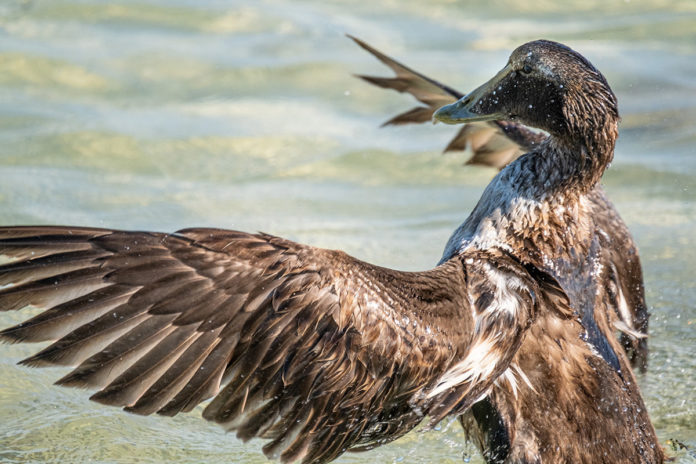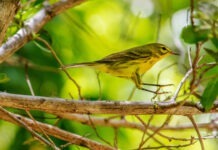When I got there, Ellen Westbrook was standing on the South Roosevelt seawall with her binoculars up, staring out at the horizon, which was a bad sign.
Gah, I thought. This is what happens when you chase birds. This is what happens when you give in to hope.
If the world was Lucy Van Pelt and rare birds were a football, I would forever be Charlie Brown thinking this time it would be different.
A gang of tourists on rental scooters went by, honking their horns like it was the funniest thing in the world and I couldn’t even summon the urge to want to flip them off.
This is what you get for trying, I thought. Defeat, despair, the taste of ashes in your mouth.
Still, I got out of the car and suited up. Binoculars, camera, sense of grim determination.
We’d both heard about the bird at the same time, but Ellen has a tendency to get most places before me – before almost everyone, actually.
I walked up behind her and asked, “Is it far out? Is it gone? Did you get to see it?”
She put her binoculars down.
“What? No, it’s right there,” she said, pointing to the foot of the seawall.
And there, just below us, 20 yards down the wall, standing on a rock in the shade, was the common eider, the southernmost common eider ever seen.
A giant jet with Delta painted on the belly in white knock-out type flew about 100 feet over our heads and disappeared behind some trees. A few seconds later, we could hear the pilot hit the thrust reversers to slow it down.
The eider did not seem bothered, one of the many no-doubt incalculable adaptations it has had to make since finding its way here.
It’s an assumption, but the kind of assumption you should go all in on if you’re a betting person, that this was the same common eider being seen around White Street Pier and Key West Bight last December. Quite a few people got to see that bird. I went out looking five or six times, but did not see it. That’s typically what happens when I chase rare birds, even the ones ridiculously close to my house. I get to see more rarities than most people, just not usually the ones I go out seeking.
“Rare bird” is a loose term. A bird can be considered rare because it has a small and/or endangered population, because it has limited habitat, because it’s a pain in the ass to find, or because it isn’t where it’s supposed to be.
The more not-where-it’s-supposed-to-be, the better. These are called vagrants or accidentals, and the common eider was definitely a vagrant.
Common eiders are cold water seaducks. They breed in the Arctic and sub-Arctic. When they migrate south they tend to travel just far enough to find water that will stay open throughout the winter. Normally they don’t get much farther south than the Carolinas.
Every once in a while, though, a bird gets a wild hair, or wild feather, and lights out for points unknown. No one is sure why this happens. Maybe they got caught in a storm. Maybe their sense of direction gets scrambled. Maybe they’ve got that Jack Kerouac gene.
If they’re lucky, birdwatchers catch sight of them, notice their out-of-placeness, take a picture and scribble some notes. But you have to wonder how many birds go far afield of their natural habitat and get missed.
In an overly simplified way, vagrancy is a way for different species to evolve. A bird (or other creature) goes astray, finds another member of its species (better yet: several other members), breeds, survives, creates subsequent generations that adapt to the local environment, the descendants’ genetic materials changing until time and separation have made them a different species. (Google “island biogeography” if you want a better explanation. Or better yet, read David Quamman’s “Song of the Dodo.”)
Although there are an estimated 1 trillion species of living things on the planet, this is a very, very, very rare occurrence, a lightning strike chance of a lightning strike chance.
The sad fact is, most vagrants don’t make it. They may survive a couple years in their new environment, but are unlikely to find their way home or more of their kind.
Common eiders are pretty hardy and adaptable beasts, the biggest ducks in the Northern Hemisphere. The males (and this one was a male) can weigh up to 7 pounds. But honestly, the bird out on South Roosevelt Boulevard was looking pretty rough, much rougher than it looked in the photos I saw from December. It was still swimming around, hunting and feeding itself, and it didn’t look emaciated, which is kind of the threshold of when rehabbers might try to intervene, but its feathers looked waterlogged when water should be, true to the cliche, running off its back.
Maybe it’s a temporary thing, or maybe a bird built to survive in the iciest of waters isn’t going to thrive in the subtropics.
Ellen and I were alerted to the bird by Peggy Koontz of Key West Wildlife Center. (Ellen actually volunteers there a few days a week.) If they hear any reports of the bird starting to fail, they may try to intervene. But even if they do, a bird that can dive to 100 feet may be impossible to catch.
Really, the best thing you can do with a rarity is hope you keep seeing it around.


























